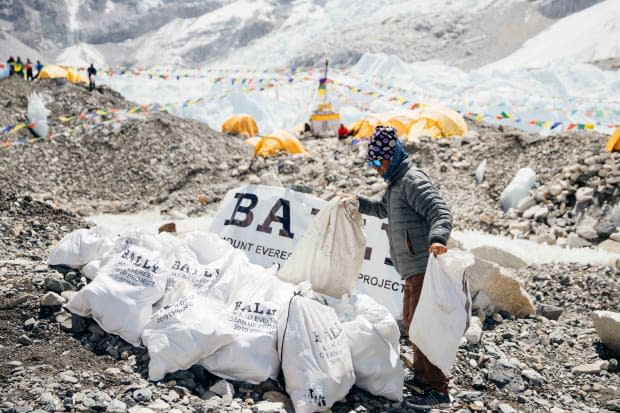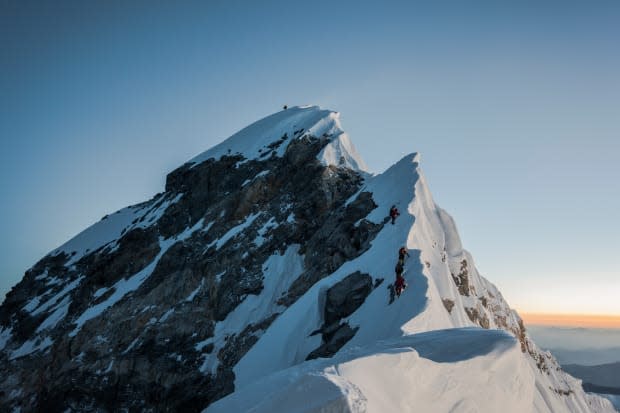The World's Tallest Mountains Are Covered in Trash, So Bally Is Cleaning Them Up
The Swiss luxury brand partnered with environmental activist and mountaineer Dawa Steven Sherpa on a series of high-risk conservation expeditions, from Everest to Kilimanjaro.
Mountains matter, and they matter to all of us.
Maybe you actively advocate for a cleaner world, of which mountains are a crucial part. Or maybe you just really enjoy skiing their snow-capped peaks a handful of times each winter. Whomever you are and however deeply you appreciate mountains, there's a very real likelihood that you're not understanding how genuinely crucial they are to our survival on Earth.
Not only do mountains cover 27% of the globe's land surface and supply more than half of humanity's fresh water, according to non-profit organization Mountain Research Initiative, they're also home to 25% of all terrestrial biodiversity, 23% of the world's forests and almost 1 billion people.
Mountains are also especially vulnerable to the effects of the planet's climate crisis. In the mountains, changing conditions like melting glaciers and disappearing snow cover are warping entire ecosystems, impacting everything from how water flows to when plants flower. So if we want to preserve the world as we know it, we have to protect mountains and the resources they offer those beyond their immediate ecosystems.
Swiss luxury fashion house Bally, for one, is doing its part. The brand, which shows at Milan Fashion Week, has long been connected to the Alps, sponsoring climbing expeditions and alpine skiing at the Winter Olympics since the early 1900s. More famously, in 1953, Bally created the reindeer boots Sherpa mountaineer Tenzing Norgay wore during the first-ever successful ascent of Mount Everest with Sir Edmund Hillary.
Last year, Bally returned to the Himalayas to launch its Peak Outlook Foundation, which aims to "safeguard the world's fragile mountain environments." The group kicked off its efforts by leading a cleanup of the mountain, from base camp to peak.

Environmental activist and mountaineer Dawa Steven Sherpa (who shares his surname with the Sherpa community, one of the Indigenous groups native to the Himalayan region) led the debut expedition, joined by his team of expert climbers and Norgay's son, Jamling.
Together, the group removed two tons of waste, half of which was collected within the mountain's "Death Zone," where the pressure of oxygen is insufficient to sustain human life for an extended period of time. (This is not a hyperbole: People die on the world's tallest mountain every year, be it from falls, storms, avalanches, lack of oxygen, freezing or other preexisting conditions.)
In 2019, an unprecedented 891 climbers reached Everest's summit, with hundreds, even thousands more international mountaineers gathering at base camp. The blooming crowds on the mountain don't just have serious safety implications — a record 11 climbers died during their summit last year — but also environmental ones.
Each spring, Everest's two principle base camps, one on the Nepal side of the mountain and the other on the opposite face in Tibet, transform into what National Geographic calls a "pop-up city": The well-provisioned camps, pitched at 17,500 feet, offer heli-pads, walk-in clinics and, for those using certain guide services, cushy social tents that allow climbers to acclimatize to the altitude.
Related articles:
18 Fashion People Recommend Their Sustainability Must-Reads
Can Fashion Shows Ever Be Environmentally Justifiable?
Up-and-Coming Model Haatepah Is Using Fashion as a Platform to Advocate for Indigenous Rights
Base camp also houses the Sagarmatha Pollution Control Committee Camp (SPCC), a community-based NGO established in 1991 by the people of northeastern Nepal's Khumbu region that manages solid waste removal from camp and along the trekking trails. "Although these practices ensure modern camps are kept relatively clean," writes National Geographic, "venture off the trail a bit and you will discover large piles of trash — the remnants of expeditions from earlier, less enlightened times."
Especially as annual visitors to base camp grow, cleanups like the ones SPCC leads are as crucial for the health of the mountain as for the Sherpa people, who have been essential to successfully summiting mountains like Everest.
When Bally first approached Dawa about collaborating on its then-prospective Everest project, he had already been a professional mountaineer for 15 years, even organizing his own small-scale cleanups each April and May. His family has been in the mountain tourism industry for three generations, starting with his grandfather who was a friend of Sir Hillary's.
"My father was born about 20 kilometers from Everest, and I still visit our house in the village there three, four times a year," he says. "All the climbers that work with me are either related to me or they're from the village or the nearby villages."

Dawa had already worked with plenty of groups that, he says, viewed mountain preservation as nothing more than a "gimmick." But upon further conversation, he was pleasantly surprised to learn the depths of Bally's commitment. For starters, the brand wished to keep the expedition under wraps until it finished overhauling its own sustainability initiatives. "Normally I have people who want to make a big fuss about it before even doing anything," he says. "But they were walking the walk before talking the talk."
Earlier this month, Bally, again in collaboration with Dawa, announced its latest initiative in the Himalayas. The two-year agenda maps out basecamp cleanups at eight of the region's highest mountains, including Everest, but also Mounts Kanchenjunga (28,169 feet), Makalu (27,825 feet), Cho Oyu (26,906 feet), Dhaulagiri I (26,795 feet), Manaslu (26,759 feet) and Annapurna I (26,545 feet).
Bally has also developed expeditions with other at-risk mountain environments beyond the Himalayas. This fall, the Bally Peak Outlook Foundation will partner with Japanese alpinist and environmentalist Ken Noguchi and the Fujisan Club on a high-altitude climb to remove waste from the inaccessible areas of Mount Fuji, a sacred symbol of Japan that, in recent years, has been plagued by record amounts of trash and waste. And in 2021, the expedition will head to Mount Kilimanjaro in Tanzania, where they plan to focus on local environmental issues, like deforestation and increasing glacial ice loss, as well as to assist local rangers in building new trails that create more sustainable access to the 19,341-foot summit.
It's a lofty program, but Dawa is optimistic about its course. It doesn't hurt that the Bally Peak Outlook Foundation counts partners from around the world, including the global International Climbing and Mountaineering Federation — commonly known by its French name, Union Internationale des Associations d'Alpinisme (UIAA) — based in Bern, Switzlerand to contribute funding and non-financial support.
As mountains fall into increasingly critical conditions, preservation — like the kind Bally is promoting — is not just a one-off project, but an all-hands-on-deck movement. "Unfortunately," says Dawa, "no matter where we humans have gone, we've left a negative impact."
Perhaps fashion can look to Bally's expeditions as an example of treading one step in the right direction, not unlike climbing Everest.